
Growing your own perennials does not have to be difficult or expensive. Sure, some seeds can be pricey or require a lot of work (chilling, warming, seed coat nicking, soaking) which can take months of effort. But, many others are cheap and nearly effortless to grow, taking little more work than starting annual seeds. Perennial gardening from seed is worth the effort.
Since the early 1990s I have been growing my own perennials from seed, from toughies like peonies to easy-to-start favorites like sunflowers, so I’ve has time to compile a list of the easiest, prettiest and heaviest blooming at the nicest price. My favorites also tend to bloom first year from seed, making the whole process even more quickly gratifying.
So where can you get the most bloom for your buck? Fast-blooming beauties like hummingbird mint (Agastache spp.), Maltese cross (Lychnis calcidonica) and purple cone flowers (Echinacea purpurea), will pop up and bloom within a matter of months in the garden. And, if you choose the right seed vendors you can really keep costs down. Some of the best for low-cost, high-quality seeds include Select Seeds (most packets cost $2.99), Pinetree Garden Seeds (many seeds are $1.25 per packet) and Botanical Interests, among many others. When you consider that perennials most commonly cost between $8.00 and $25.00 per plant, depending on the size, it clearly pays to start from seed.
Easy, fast, first-year perennial bloomers are more common than you’d imagine, so it’s not hard to find high-performing gems in the mix. Each year I grow one or more of my favorites indoors from seed in Black Gold Seedling Mix under fluorescent grow lights. (For a full seed starting tutorial click here!) Some of the easiest and prettiest include:
Sunset Hummingbird Mint (Agastache rupestris)
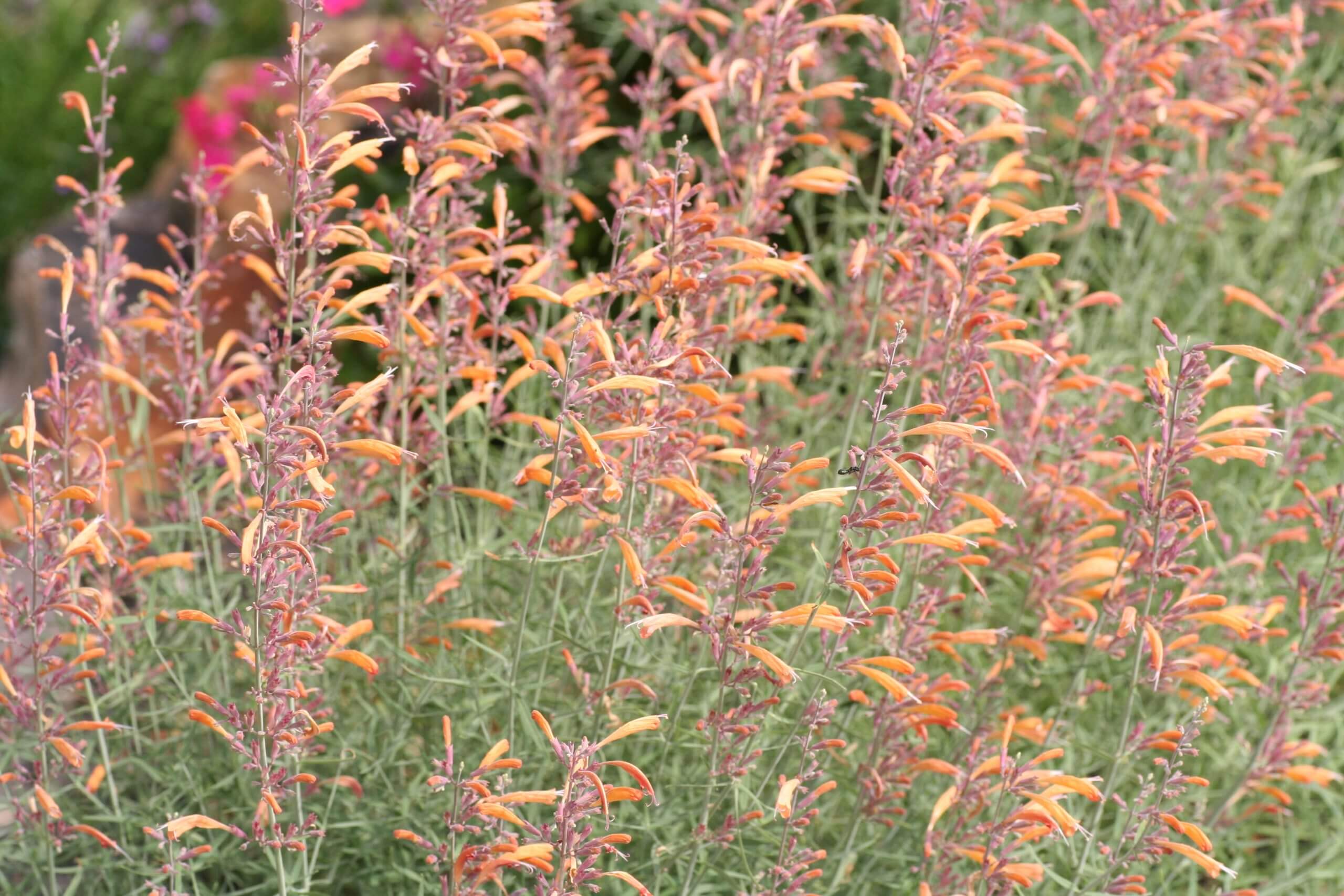 Since first growing this beautiful fragrant mint in the Purdue University Horticulture Gardens in 1997, I have been hooked it. Not only does the silvery, bushy perennial bloom in the first year, bearing ethereal blooms of orange-purple that are beloved by hummingbirds, but it heartily blooms and grows for up to three or four years, thriving in heat and sun. The only enemy of this western native is wet or poorly drained soil.
Since first growing this beautiful fragrant mint in the Purdue University Horticulture Gardens in 1997, I have been hooked it. Not only does the silvery, bushy perennial bloom in the first year, bearing ethereal blooms of orange-purple that are beloved by hummingbirds, but it heartily blooms and grows for up to three or four years, thriving in heat and sun. The only enemy of this western native is wet or poorly drained soil.
Seed Starting: Lightly cover the seeds with seed starting mix and keep slightly moist. Maintain a temperature of 68º F and keep seed pots 4 inches from grow lights for best results. Germination takes less than 10 days.
Purple Coneflower (Echinacea purpurea)
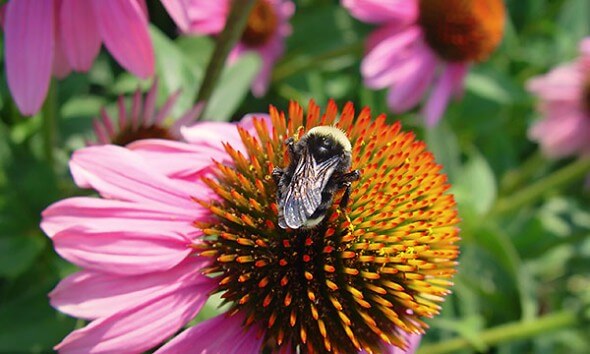 Everyone loves the rosy purple flowers of the purple coneflower, and seed growers love how easy they are to start! What’s more, some lovely cultivars can be grown from seed. This year I am trying ‘PowWow Wild Berry‘, which boasts brilliant berry colored blooms on well-branched plants.
Everyone loves the rosy purple flowers of the purple coneflower, and seed growers love how easy they are to start! What’s more, some lovely cultivars can be grown from seed. This year I am trying ‘PowWow Wild Berry‘, which boasts brilliant berry colored blooms on well-branched plants.
Seed Starting: Lightly cover seeds with seed starter, keep them slightly moist, and maintain a temperature of 68º F. Germination should occur within three to four weeks, sometimes earlier.
Blackberry lily (Belamcanda chinensis)
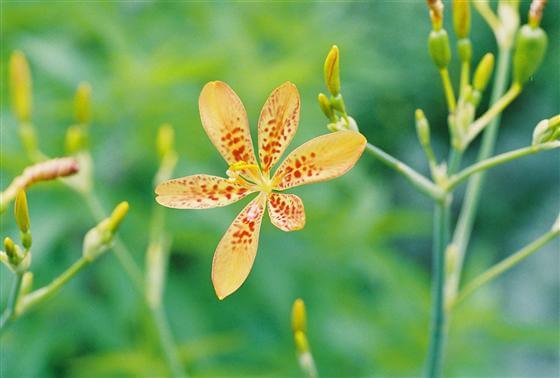 Beautiful spotted orange summer flowers give way to blackberry-like seed clusters in fall. The only caveat is that the attractive seedheads must be cut before they shatter in mid-fall because this hardy perennial can self-sow prolifically.
Beautiful spotted orange summer flowers give way to blackberry-like seed clusters in fall. The only caveat is that the attractive seedheads must be cut before they shatter in mid-fall because this hardy perennial can self-sow prolifically.
Seed Starting: The large seeds have a shiny black exterior that’s easily cracked or nicked. Some feel the seeds germinate faster if cracked or barely nicked. lightly cover the seeds and grow them under the same conditions as the purple coneflower seeds, though growing temperatures should be slightly warmer, at 72º F. Germination will happen but can be a little irregular occurring within a three to four week period.
Blanket Flower (Gaillardia x grandiflora)
 Few summer bloomers can top the resilience, beauty and ever-blooming nature of this tough, North American native. The perennial blanket flower thrives in high sun and heat and will keep blooming and blooming into fall is well cared for and regularly deadheaded. It’s also remarkably easy to start from seed. Lots of fun cultivars exist. The classic ‘Fanfare’ is a good one for those new to the plant.
Few summer bloomers can top the resilience, beauty and ever-blooming nature of this tough, North American native. The perennial blanket flower thrives in high sun and heat and will keep blooming and blooming into fall is well cared for and regularly deadheaded. It’s also remarkably easy to start from seed. Lots of fun cultivars exist. The classic ‘Fanfare’ is a good one for those new to the plant.
Seed Starting: Lightly cover seeds with seed starter, keep lightly moist and maintain a temperature of 68º F. Germination should occur within one to two weeks, sometimes a bit longer.
False Sunflower (Heliopsis spp.)
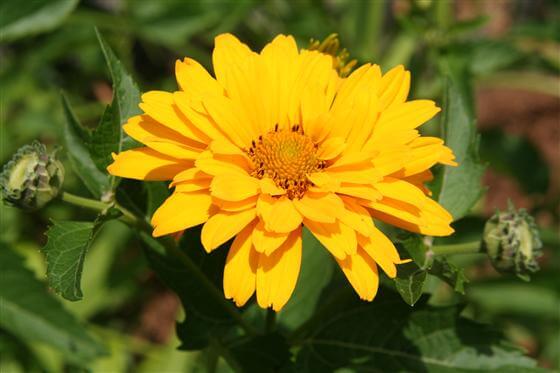 This tough, sun-loving sunflower relative bears cheerful yellow flowers in summer. Several nice cultivated varieties can be grown from seed, most notably the charming semi-double-flowered Helianthus scabra ‘Summer Sun’ (‘Sommersonne’) and ‘Sunburst, which has variegated foliage and bright yellow flowers.
This tough, sun-loving sunflower relative bears cheerful yellow flowers in summer. Several nice cultivated varieties can be grown from seed, most notably the charming semi-double-flowered Helianthus scabra ‘Summer Sun’ (‘Sommersonne’) and ‘Sunburst, which has variegated foliage and bright yellow flowers.
Seed Starting: Lightly cover seeds with seed starter, keep lightly moist and maintain a temperature of 68º F. Germination should occur within one to two weeks, sometimes a bit longer.
Lady Lavender (Lavandula ‘Lady’)
 This classic AAS winning lavender truly blooms first year from seed producing bountiful, fragrant lavender blooms on compact, silvery plants. I first grew it around 1998 with great success. The plants can be a little less hardy that English lavender, but they will still survive for several years in USDA zones 7-9 (some references say they will survive in zone 6, but my experience says otherwise).
This classic AAS winning lavender truly blooms first year from seed producing bountiful, fragrant lavender blooms on compact, silvery plants. I first grew it around 1998 with great success. The plants can be a little less hardy that English lavender, but they will still survive for several years in USDA zones 7-9 (some references say they will survive in zone 6, but my experience says otherwise).
Seed Starting: Lightly cover the seeds with seed starting mix and keep them just moist, never wet. Maintain a temperature of 68º F and keep seed pots 4 inches from grow lights for best results. Germination should take around two to three weeks.
Spotted horsemint (Monarda punctata)
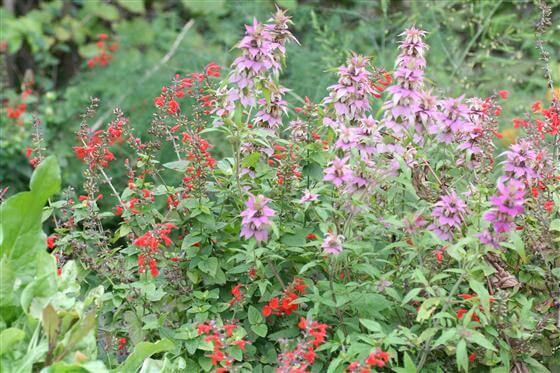 Bees and hummingbirds love the pink tiered flowers of this quick-to-bloom, short-lived perennial Monarda. It’s fragrance and unusual, pretty looks will make you glad you grew it.
Bees and hummingbirds love the pink tiered flowers of this quick-to-bloom, short-lived perennial Monarda. It’s fragrance and unusual, pretty looks will make you glad you grew it.
Seed Starting: Lightly cover the seeds with seed starting mix and keep them just moist, never wet. Maintain a temperature of 68º F and keep seed pots 4 inches from grow lights for best results. Germination should take around two weeks or less.
Atlantic Poppy (Papaver atlanticum)
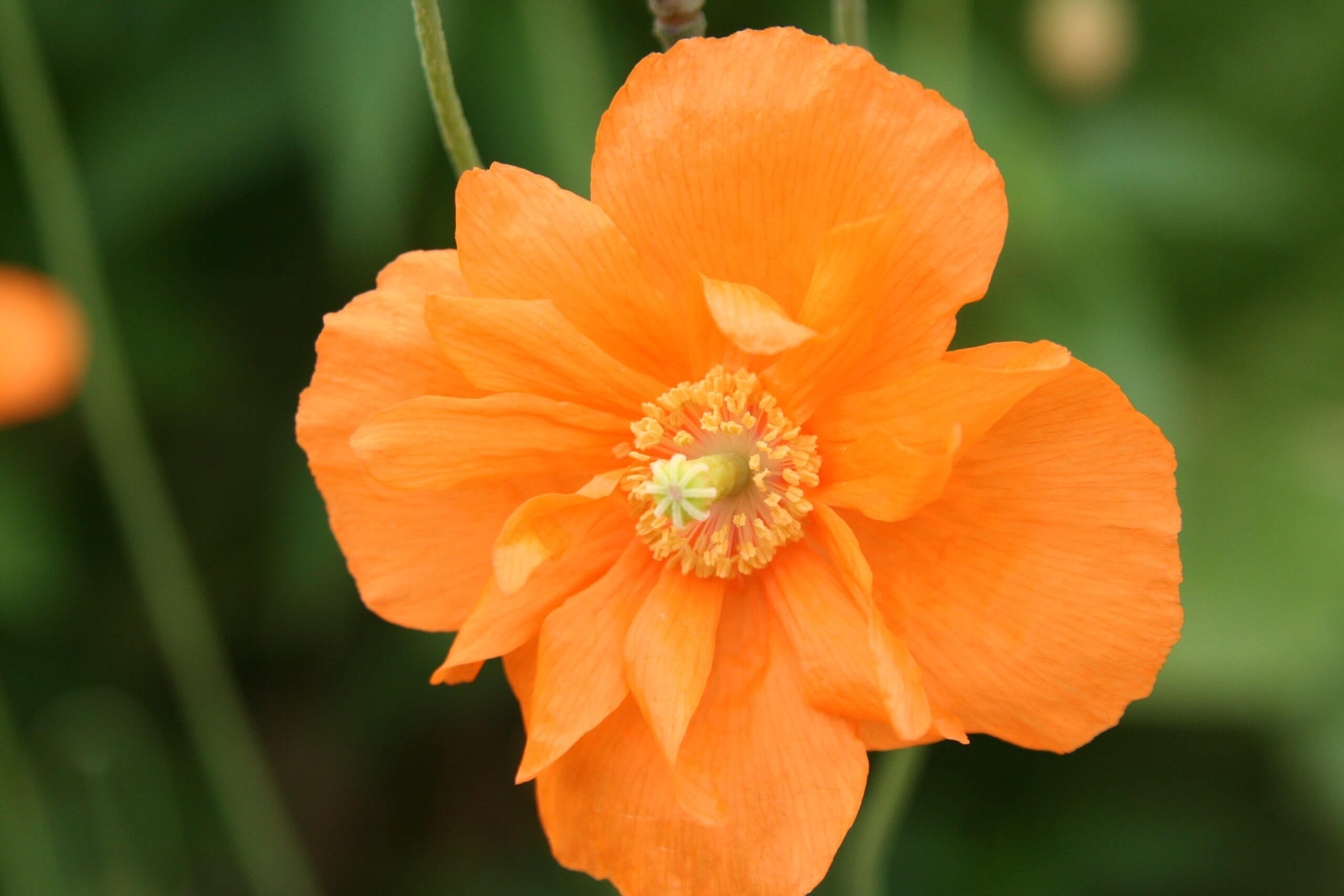 The delicate summer blooms of this orange poppy keep coming for months if you keep them deadheaded. The plants are quite tough, surviving heat and drought, and might even self-sow, if they are planted in a sunny spot on well-drained ground.
The delicate summer blooms of this orange poppy keep coming for months if you keep them deadheaded. The plants are quite tough, surviving heat and drought, and might even self-sow, if they are planted in a sunny spot on well-drained ground.
Seed Starting: Do not cover the seeds, but sprinkle them on top of the seed starting mix, keeping them lightly moist. Maintain a temperature of 68º F and keep seed pots 4 inches from grow lights for best results. Germination should take around two weeks or less.
Grayhead Coneflower (Ratibida pinnata)
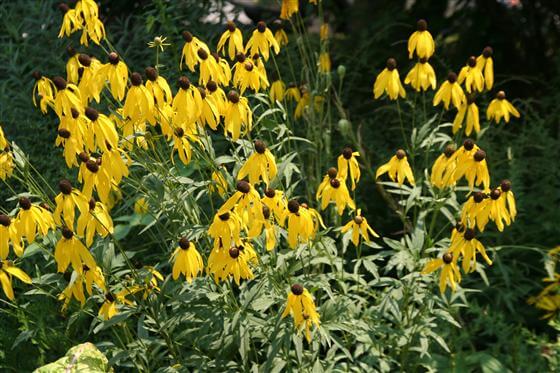 Bright yellow daisies with drooping yellow petals cover this prairie native in midsummer. My plant has survived for 8 years, so the hardy, sun-loving plants can be quite long lived.
Bright yellow daisies with drooping yellow petals cover this prairie native in midsummer. My plant has survived for 8 years, so the hardy, sun-loving plants can be quite long lived.
Seed Starting: Lightly cover the seeds with seed starting mix and keep them just moist, never wet. Maintain a temperature of 68º F and keep seed pots 4 inches from grow lights for best results. Germination should take around two weeks or less.
Brown-Eyed-Susan (Rudbeckia triloba)
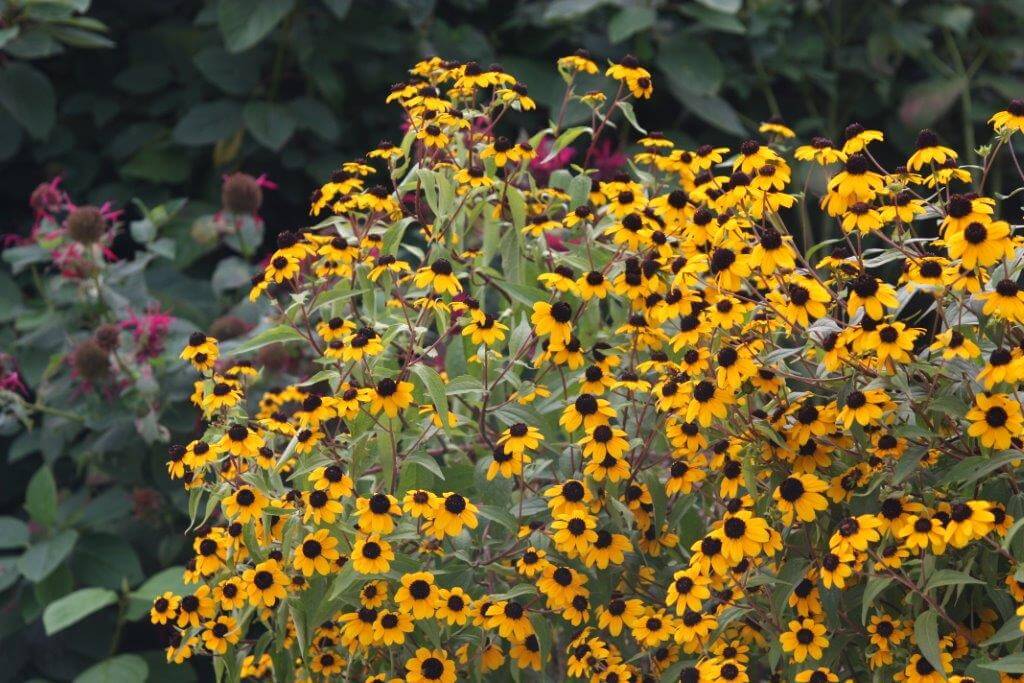 Clouds of little brown-eyed daisies cover this underused native perennial from mid- to late summer. The bees love it too.
Clouds of little brown-eyed daisies cover this underused native perennial from mid- to late summer. The bees love it too.
Seed Starting: Lightly cover seeds with seed starter, keep lightly moist and maintain a temperature of 68º F. Germination should occur within one to two weeks, sometimes a bit longer.
Caradonna Salvia (Salvia nemorosa ‘Caradonna’)
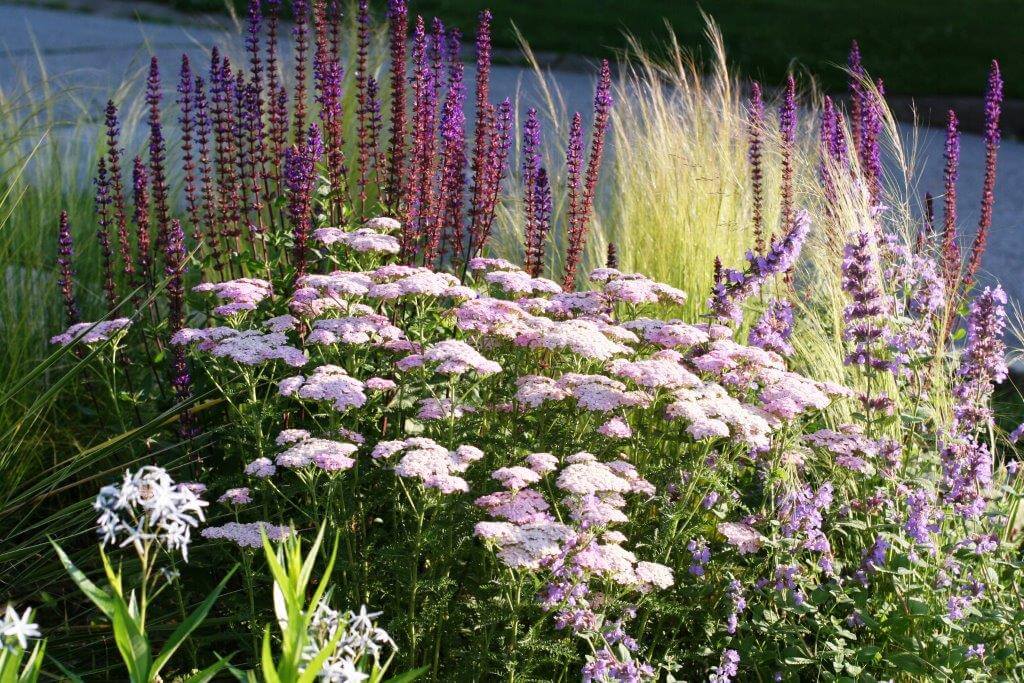 Spikes of purplish red salvia flowers line the upright, dark purple stems of this salvia from early to late summer, if plants are regularly deadheaded. If plants are started in February, they should bloom in the first year from seed.
Spikes of purplish red salvia flowers line the upright, dark purple stems of this salvia from early to late summer, if plants are regularly deadheaded. If plants are started in February, they should bloom in the first year from seed.
Seed Starting: Lightly cover the seeds with seed starting mix and keep slightly moist. Maintain a temperature of 68º F and keep seed pots 4 inches from grow lights for best results. Germination takes around three weeks, sometimes longer.
These are but a few of the easy-to-start and fast-to-please perennials that I’ve enjoyed over the years and encourage gardeners to try in 2014. And if you are like me, you’ll have so much success with your perennials seed starting venture, you’ll have plenty to share with other gardening friends. Speaking of sharing, I also encourage readers to share any other easy perennials that they have found success with. We welcome comments and community on this blog!

